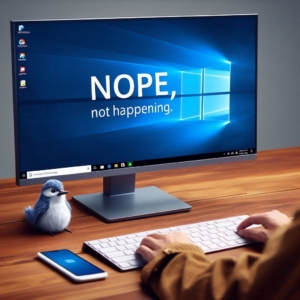If Your Windows 10 Computer Cant Run Windows 11

My Computer Can’t Run Windows 11! What Now?
So, you’ve heard about Windows 11, but your computer says “nope, not happening.” Don’t worry, you’re not alone! Lots of people are in the same boat. But what does this mean for you and your computer? Let’s break it down.
What Does It Mean?
Basically, your computer is too old for Windows 11. It’s like trying to fit into clothes that are too small. Windows 11 is a newer, fancier version of Windows that needs a newer, faster computer to work properly.
1. Stick with Windows 10
Windows 10 is still a great operating system. Microsoft will support it with updates and security patches until October 14, 2025. This means you have a few more years of safe and secure use.
What to do:
- Keep your system updated: Regularly check for updates by going to Settings > Update & Security > Windows Update.
- Use security software: Install good antivirus and anti-malware programs.
2. Upgrade Your Hardware
If you really want to use Windows 11, you might need to upgrade some parts of your computer. Windows 11 has specific hardware requirements, like a compatible processor, TPM 2.0, and enough RAM.
What to do:
- Check compatibility: Use the PC Health Check app from Microsoft to see what’s missing.
- Upgrade components: Consider upgrading your processor, adding more RAM, or enabling TPM 2.0 if your motherboard supports it. This might require professional help.
3. Buy a New PC
Sometimes, upgrading an old PC isn’t worth it. If your computer is very old, it might be better to buy a new one that comes with Windows 11.
What to do:
- Research new PCs: Look for computers that fit your budget and meet your needs.
- Transfer your data: Use an external hard drive or cloud storage to move your files from the old PC to the new one.
4. Switch to a Different Operating System
If you’re open to trying something new, there are other operating systems like Linux that can run on older hardware. Linux is free and has many versions (called distributions) that are user-friendly.
What to do:
- Choose a distribution: Some good ones for beginners are Ubuntu and Linux Mint.
- Install Linux: Follow online guides or watch tutorials on YouTube for installation steps.
5. Use Your Current PC for Specific Tasks
Even if you can’t upgrade to Windows 11, your Windows 10 PC can still be useful for certain tasks like browsing the web, watching videos, or using it as a secondary computer.
What to do:
- Optimize your system: Uninstall unnecessary programs, clean up your hard drive, and disable startup programs to keep it running smoothly.
- Repurpose it: Turn it into a media server, a dedicated gaming machine for older games, or use it for learning new skills.
Not being able to upgrade to Windows 11 isn’t the end of the world. You have plenty of options to keep your computer useful and secure. Whether you stick with Windows 10, upgrade your hardware, buy a new PC, try a different operating system, or repurpose your current machine, there’s a path forward that suits your needs.
Keep exploring and find what works best for you!
Need help keeping your Windows 10 computer running as long as possible?


